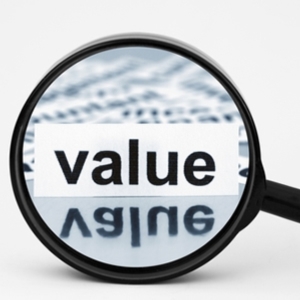 Several of my current clients are startup companies that understand that, to have real value, their patents must be seen by a third party as meaningful to the opportunity–be it customers, revenue stream, or any other business strategy–that this potential potential partner, licensor, or acquirer seeks to access. Put another way, patents generated by early stage companies that are developing innovative technology must “make it cheaper to go through them than around them.” For these types of patent owners, due diligence conducted by third parties is more than just “kicking the tires” of the patent portfolio; instead, their patents will be examined by an expert team to make sure they won’t “break” just when they’re needed most.
Several of my current clients are startup companies that understand that, to have real value, their patents must be seen by a third party as meaningful to the opportunity–be it customers, revenue stream, or any other business strategy–that this potential potential partner, licensor, or acquirer seeks to access. Put another way, patents generated by early stage companies that are developing innovative technology must “make it cheaper to go through them than around them.” For these types of patent owners, due diligence conducted by third parties is more than just “kicking the tires” of the patent portfolio; instead, their patents will be examined by an expert team to make sure they won’t “break” just when they’re needed most.
As an initial aspect of this discussion, it should be stressed that not all patents are equal in value. Some patents–and, in my view, this is the vast majority of patents—do not really matter much to the fortunes of their owner. For example, a patent obtained by an established organization likely won’t make or break the company. Sure, it will be disappointing if the company introduces a product that a competitor can knock off without incurring legal liability, but this likely means only that the expected revenues will not be achieved that motivated the expense and effort to introduce that product to the market. While profits may decline, the company will not typically go out of business. Moreover, in my 20 plus years as a patent professional, I have never seen anyone officially blame a failure to achieve revenue projections on the company’s obtaining of inadequate patent protection (even though I can see this occur frequently in my practice). It can therefore be said that most patents do not need to be (or appear to be) “unbreakable.”
In contrast, a startup has likely “bet the company” on developing a technology for a specific market or customer. For those few ventures that are successful in matching a product to customers in a scalable market, it can usually be expected that other companies will want a piece of the action. Those companies will then be faced with a Build vs. Buy decision: if it makes more sense to go it alone to acquire the customer they will invariably do so, especially if they are legally free to go this route. Strong patents—that is, patent coverage that protects the customer value proposition, as opposed to merely only protecting a specific product provided to the customer—therefore becomes a critical aspect of the incumbent’s Build vs. Buy decision for an early stage company seeking to gain the attention of the established company.
To this end, two of my clients have recently gone through due diligence with established companies that sought access to each of their innovative technologies, even though neither had yet generated many customers. My clients’ respective values to these incumbents was primarily their technology solutions, which we had endeavored to protect broadly with patent filings. Each of these incumbents saw value in being able to sell to the potential customers who were served by my clients, even though the customers are today only hypothetical. The incumbents saw future revenue streams from these customers as desirable, but first they needed to determine whether these would be sustainable in a way that justified the investment in my respective clients. A significant component of the sustainability question was embodied in the content and scope of the patent filings. If the patents could be “broken,” then the sustainability of the revenue streams would be in question.
In each of these client due diligence situations, the incumbents’ patent experts “stress tested” my clients’ patent filings. The crux of the evaluation looked at the content and scope of the filings to establish whether they would create a sustainable competitive advantage for them if they ended up owning the patents. The experts inquired as to the scope of our prior art reviews (extensive) and the strategy for generating claims that protected not only the “how” (e.g., the product), but also the “why” (e.g., the customer value). They also evaluated the skill with which we navigated the application through the Patent Office. Each of these elements can be crucial to the “breakability” of a patent in the future.
Notably, the frame of reference of patent value for these incumbent companies was different for those of my early stage clients. Most startups like my clients have (and should have) no interest in suing another company for patent infringement. Indeed, I tell my early stage clients “if you’re thinking about litigation, you’re planning to fail in your business strategy.” This should make sense—my clients are in the business of developing technology that solves meaningful unmet customer needs that can generate sustainable and scaleable revenue. Their business models do not have room to spend oodles of money on lawsuits. (Don’t believe me? See how fast an investor runs when you tell her that you want to use her investment on litigation!) It follows that strong patent protection generated by an early stage company could have a valuation that should be measured only from the value that a potential licensor or acquirer places on the patent.
In this regard, incumbent companies with products, customers, markets, and distribution channels already possess business models. Presumably, parts of these established business models incorporate an understanding of their competitors, and how patent protection may or may not affect the behavior of others in their markets. These incumbents have much deeper pockets and, likely, existing budget allocations for legal expenses such as litigation. When doing due diligence on the patent portfolio of an early stage company that has developed interesting technology, these established companies will be interested in whether the patents held by the company could be easily “broken” (or at least appear to be “breakable”) by a competitor that was intent on competing for those same customers. An “unbreakable” patent—or even one that would be hard (i.e., expensive) to break–will often be a significant driver value for an early stage company because the licensor or acquirer will appreciate that a competitor may be locked out of a market by virtue of strong patent protection. In other words, the overall objective of due diligence in licensing or acquisition is to determine whether my clients’ patent portfolios would “make it cheaper to go through them than around them” with respect to their competitors?
This begs the question of how entrepreneurs who believe that patents are a critical aspect of their business value can better select their patent professionals. This is a hard question to answer in the abstract, but I can provide a general perspective based on my own experience. I was recently asked by a client that is in the patent drafting stage how I work to make sure that we are generating patent protection that will make the multi-billion dollar companies to which this company seeks to license its technology view our patents as “unbreakable” such that they would go through us rather than around us. I answered, “when you break things, you know how they work.” I look at patent protection strategy like this because, early in my legal career, I was an IP litigator. In this role, I spent a whole lot of time “breaking” other company’s patents (and trying to keep my clients’ patents from being “broken” by the lawyers of my clients’ competitors). Applying this experience to my work as a patent prosecutor in my next job made me very conscious of how the actions I was taking during the patenting process would potentially have on the “breakability” of that patent in relation to any subsequent activity in which that patent may be relevant, be it licensing, litigation, or otherwise. Further, I can confirm that other patent professionals that I know and work with now and in the past who have both substantive litigation and patent prosecution experience tend to look at patents from a similar framework.
Unfortunately, structural issues that underlay the legal profession do not incentivize either lawyers or law firms to allow someone to gain substantive training in both patent litigation and patent prosecution during the training phase of their careers. To make the economics work, a young lawyer must typically choose a practice focus early. This was certainly the case for me when I started practice as an IP litigator. However, I was lucky enough to be able to switch gears after a few years to retrain as a patent prosecutor. While not a common career trajectory, it is possible to find experienced folks who made the switch. Indeed, I have several colleagues with whom I collaborate who have this varied skill set.
In closing, I’ll restate what I say to most of my startup clients on a regular basis: patents rarely matter, but when they matter, they matter a lot. If your business strategy is premised on how your patents can make it desirable for another company to license or acquire your company’s technology, your patents matter a lot. Patents in this category must not appear “breakable” in due diligence. Rather, such patents must appear to be solidly crafted when subjected to a review by an expert who is motivated to find flaws in the drafting or prosecution. Accordingly, if you are a decision maker in an early stage venture that needs patents that can stand up to such stress testing, you would be well-served by looking more broadly for patent expertise than you do for matters that are of lesser importance to the success of your company. While it may not be easy to find someone with the expertise to make a patent look “unbreakable” to a third party, the fortunes of your company may depend on your going the extra mile to find the right expert.


